The sewer hose – lovingly referred to as the “stinky slinky” – is one of the most critical accessories for your RV. Routine hose maintenance makes for a more enjoyable camping experience. So let’s talk about tips for caring for your RV sewer hose!
Tips For Caring For Your RV Sewer Hose
It’s not glamorous, but a clean sewer hose is a whole lot more fun than a dirty one. Neglect is probably the single most devastating culprit when it comes to sewer hose maintenance. But if you don’t know what to do, it’s hard to get started.
Here are some tips to keep your sewer hose in good working order:
Tip #1: Empty Your Holding Tanks Correctly
There may be more to this step than you expect. So start by consulting our step-by-step guide to emptying your RV’s holding tanks. Following that guide when dumping your RV is one of the best things you can do to keep your sewer hose in good condition.
If we sum up the major takeaway, however, it would be to empty black water first and then empty your gray water tank to flush as much solid waste out of the hose as possible.
This ensures the worst of your RV’s wastewater is washed away with the soapy water from your shower and sinks. In fact, if you need to empty out your black water tank but don’t have much in the gray tank, do an extra load of dishes or take a quick shower to make sure there’s enough gray water to clean out your sewer hose.
Tip #2: Keep Your Holding Tanks as Clean as Possible
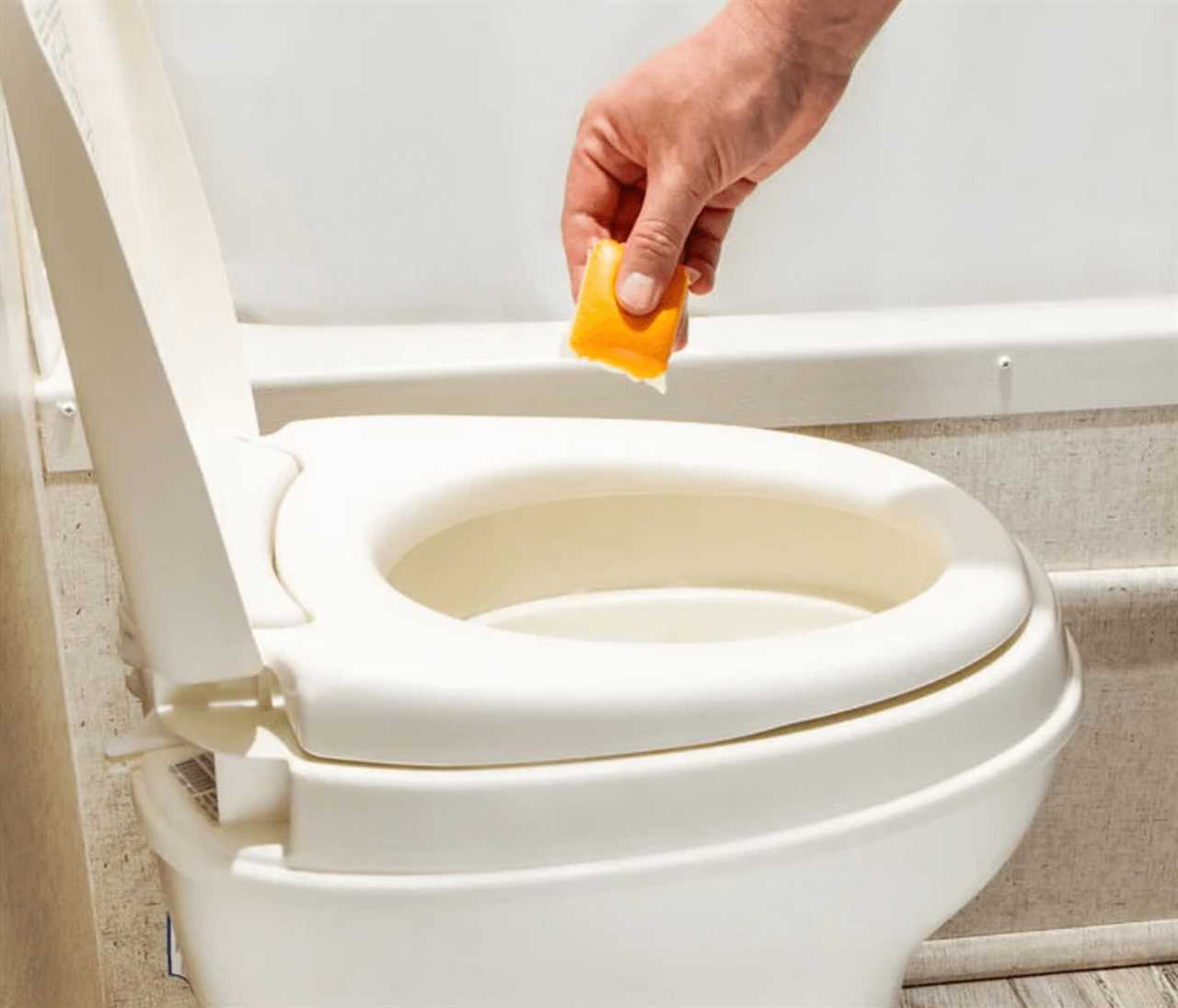
PC Camping World
Sure, your tanks are made to hold some gross stuff, but that doesn’t mean you shouldn’t make sure they’re as clean as possible. Being mindful about what you put down your sinks and toilet is a great first step. These tips will keep your tanks cleaner and your sewer hose will thank you too!
- Use RV-friendly toilet paper.
- Or dispose of toilet paper in a waste bin to keep it out of your system entirely.
- Clear leftover food waste into the trash before rinsing dishes.
- Avoid using harsh chemicals that aren’t designed for RVs when cleaning sinks, toilets, and showers.
- Use the black tank flush—if your RV has one—every time you empty your tanks.
- Or at least at the conclusion of each trip.
- If you don’t have a black tank flush, use a tank cleaning wand at the same intervals.
- Regularly treat your tanks with the recommended chemicals.
- Once a year, pour a gallon of hot water and dishwashing detergent into your tanks. Drive around for 15-20 minutes to dislodge debris from the sides of your black tank.
- This also helps clear holding tank sensors for accurate level readings.
At home, it’s a blessing that most of our waste is out of sight and out of mind after it gets flushed or rinsed down the drain. In an RV, you are directly responsible for dealing with that waste again when your holding tanks are full.
The more careful you are about what goes into your holding tanks, the less you’ll have to worry about it negatively impacting your sewer hose when it comes out.
Tip #3: Add a Clear Elbow to Your Sewer Hose Kit
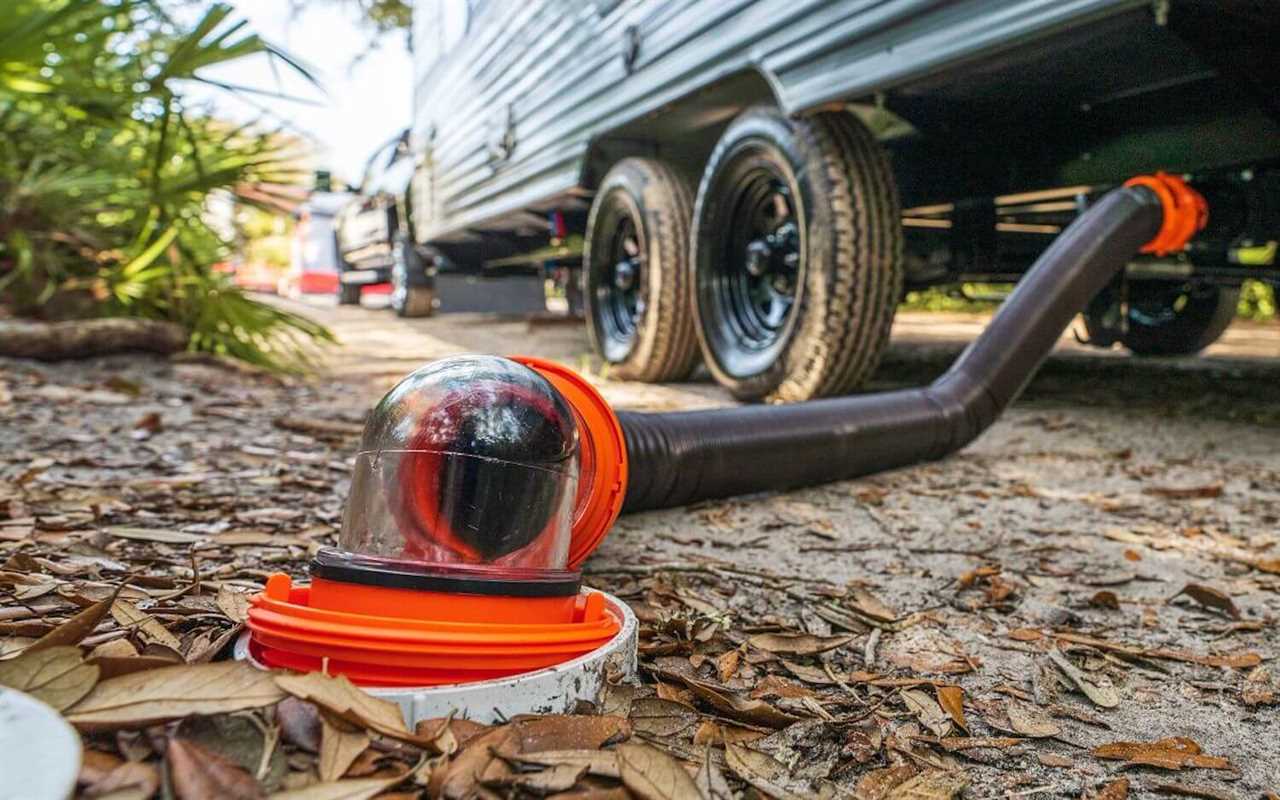
PC Camping World
A problem that many new RVers run into is knowing when their tanks are actually empty at the conclusion of the dumping process. A clear sewer hose elbow is the only real way to visually check when there is no longer any waste emptying from your tanks.
It also has the benefit of allowing you to check what’s coming out of your hoses. It might not sound pleasant, but it will help you avoid disconnecting a sewer hose that still has dirty waste inside. Once the water runs clear through the elbow, your hose is about as clean as it’s going to get.
Tip #4: Use a Sewer Hose Rinse Cap
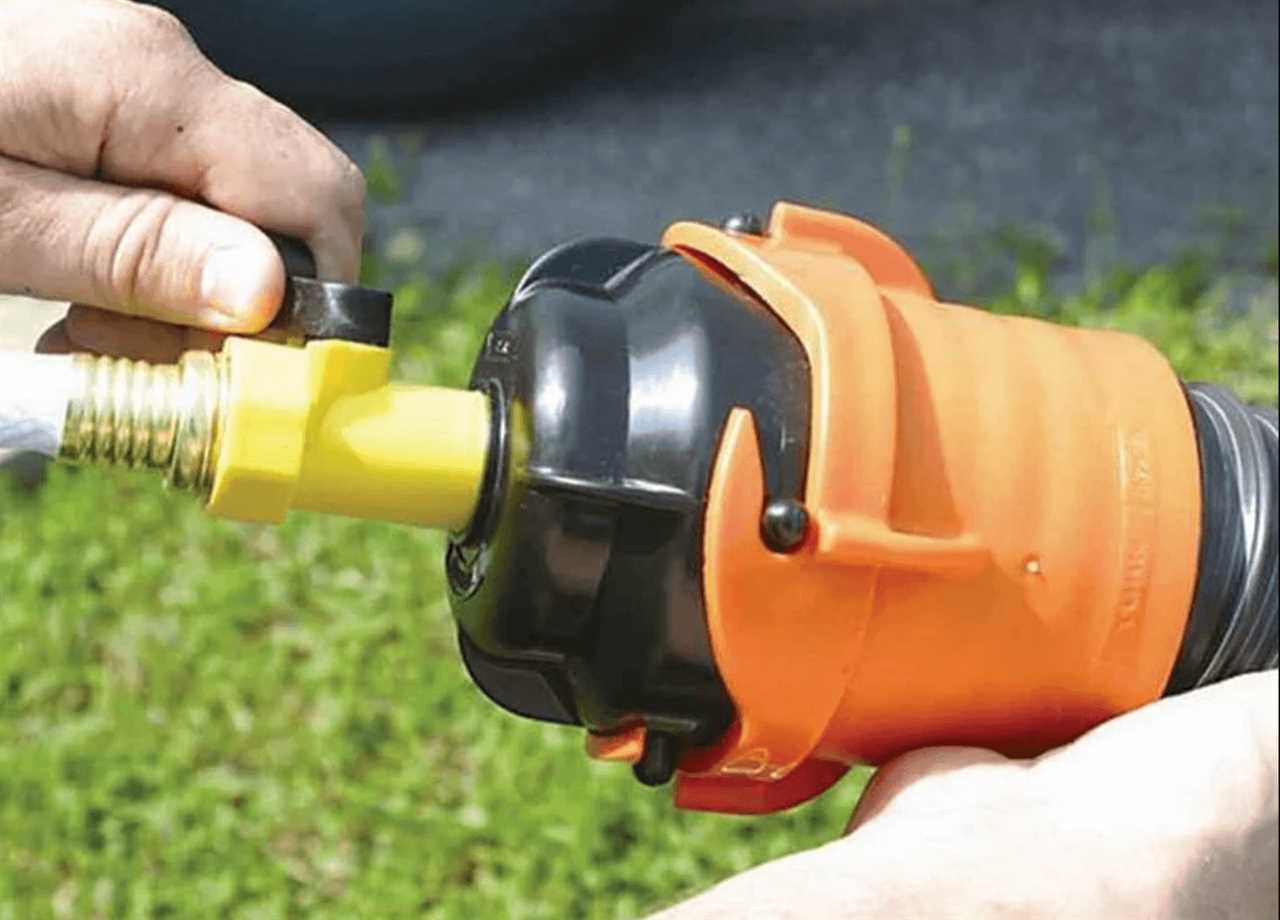
PC Camping World
At the end of your dumping process, you should always start by disconnecting your sewer hose from your RV first. Many RVers then take a hose hooked up to a clean water source and do a final rinse of the inside and outside of the hose before disconnecting the downstream end.
While you can use a regular garden hose, installing a sewer hose rinse cap will shoot water directly into the sewer hose to rinse it out.
One end of the sewer hose rinse cap will have a standard water hose connection and the other will have a bayonet that connects to your sewer hose. This allows you to avoid splashing residue (yes, it’s not the best visual) where you don’t want it when performing this final rinse.
DO NOT use your fresh/drinking water hose to feed the sewer hose rinse cap. It’s not a direct connection between the inside of your sewer hose and the end of the fresh water hose, but better safe than sorry.
Tip #5: Keep Your Sewer Hose Out of the Dirt
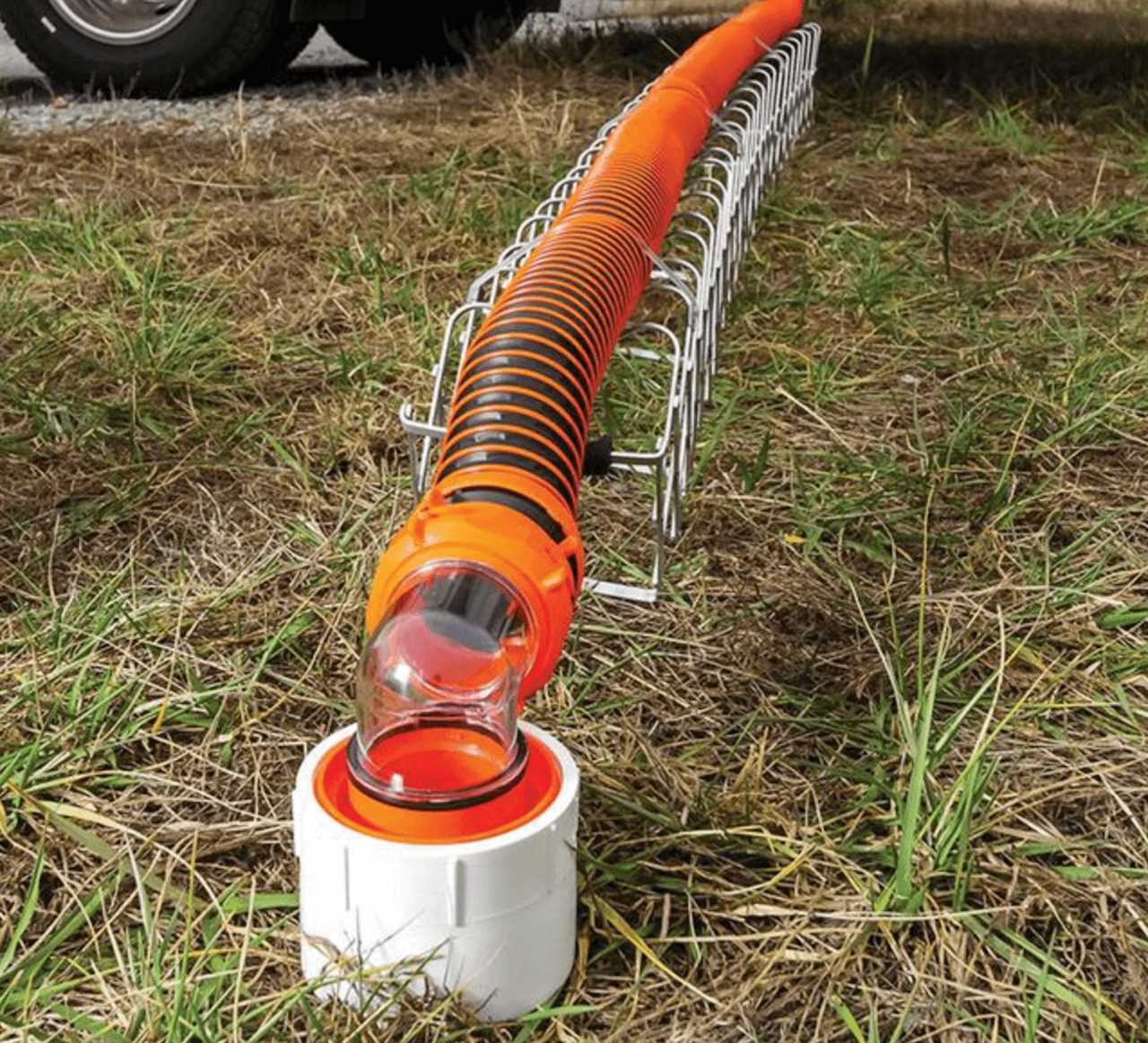
PC Camping World
We’ve spent a lot of time taking care of the inside of your sewer hose, now let’s focus on the outside. Instead of laying your hose right on the ground, keep it out of the dirt by using a flexible sewer hose support.
Sewer hose supports collapse so they don’t take up much space inside your RV. And besides keeping your hose off the ground, they put your hose on a natural incline so gravity helps your RV waste flow out more smoothly.
Using a sewer hose support eliminates having a low spot in the center of your hose where waste can collect. This reduces the amount of waste you’ll have to clear from your hose at the conclusion of the tank emptying process. So this is a no-brainer for keeping both the inside and outside of your sewer hose clean.
Tip #6: Safely Store Your Sewer Hose While Traveling
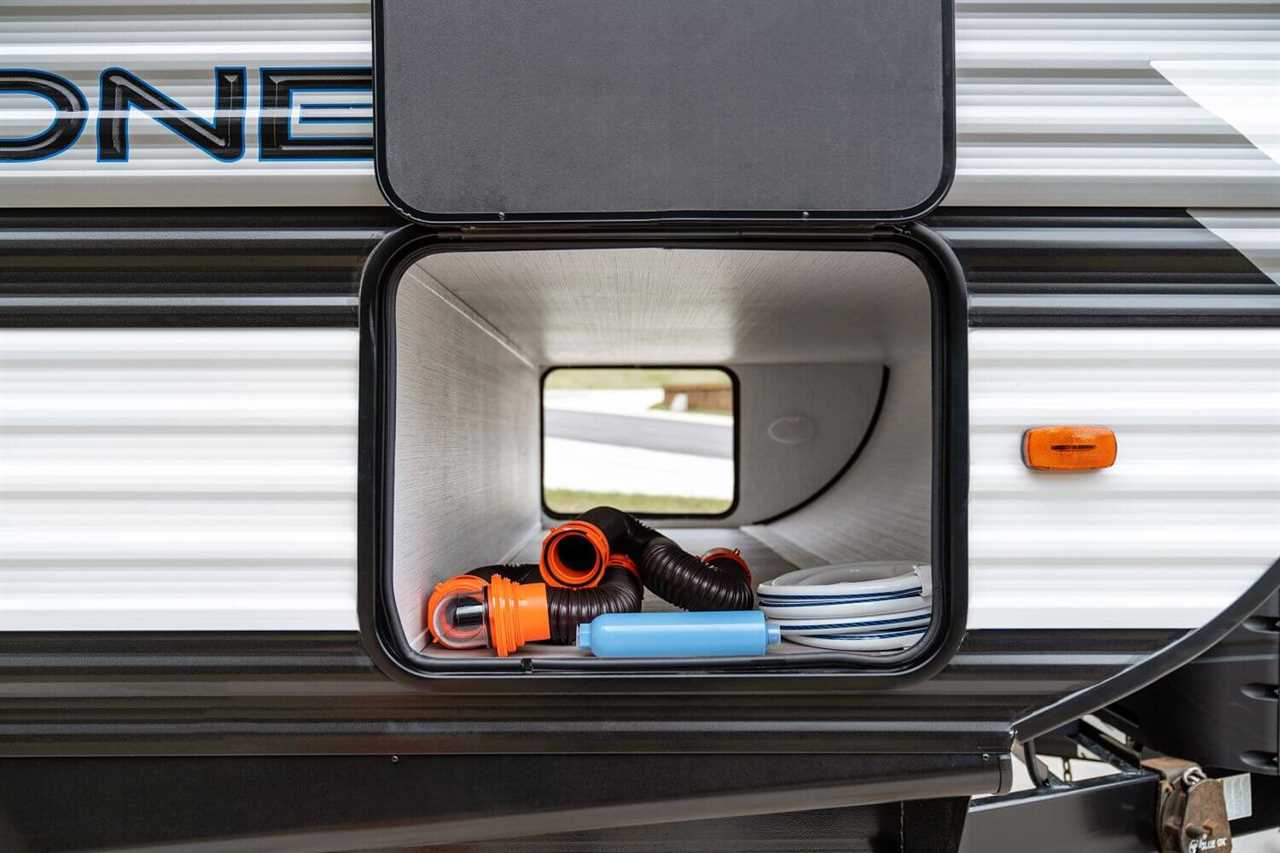
PC Camping World
A lot of people swear by storing their sewer hose in a five-gallon bucket inside an underneath storage compartment. But it’s a good idea to clean and store your hose outside of your RV’s main storage areas if possible.
Many RVs offer storage for your sewer hose in the rear bumper. This is your best option for storing your RV sewer hose if it’s available to you. However, you should consider traveling with at least two lengths of hose so you’re prepared if the sewer hookup is further away.
There are a few ways to store this second hose (or your first hose if your coach doesn’t have bumper storage). The easiest way is to find a lidded storage box that’s big enough to fit your sewer hose and small enough to fit smartly in an underneath storage compartment.
If your bin is large enough, you can also store accessories like swivel fittings and sewer hose supports inside. This is an easy way to create your own RV sewer hose kit that’s organized and ready to go when you need it.
Another option is to mount another hose carrier to your RV. If you’re crafty, some PVC pipe and a couple of fittings will do the job too.
Tip #7: Air Dry Your Hose Between Trips
As part of your post-trip RV care and maintenance, it’s a good idea to make sure your hose is completely dry. Leaving a wet hose in an enclosed storage area can promote mold or mildew accumulation inside the hose.
So take it out of your rear bumper or storage bin and stretch it out completely. Ideally, do this in direct sunlight to speed up the process. Then, you can go about cleaning and unpacking your RV like you would at the conclusion of every trip. Just pack up your hose again when you’re done.
Proper RV Sewer Hose Care Goes a Long Way
Your sewer hose is one of the most important things in your RV. It gives you a sanitary way to empty your holding tanks at any RV dump station or campground with full hookups. Without it, things can get messy.
If you keep these tips in mind when caring for your sewer hose system, the messiest part of RVing will be a breeze. For more attachments that help to extend the life of your sewer hose, check out our collection of RV sewer connections, including adapters and other helpful attachments.
What tips do you have for caring for your sewer hose system? Share in the comments! If you need a sewer hose or sewer hose accessories, check out Camping World’s selection.
If you’re still learning the ins and outs of RV maintenance, check out our downloadable RV ownership and maintenance booklet!
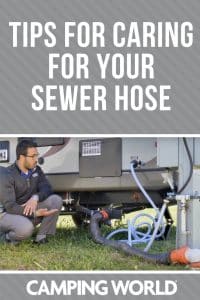
By: Mike Tiojanco
Title: Tips for Caring for Your RV Sewer Hose
Sourced From: blog.campingworld.com/at-the-campsite/tips-tricks/caring-for-your-sewer-hose/
Published Date: Wed, 30 Mar 2022 15:55:00 +0000
---------------------------------------------
Did you miss our previous article...
https://outdoorsnewswire.com/camping/5-rules-for-taking-your-pets-on-the-road
 CampingSurvivalistHuntingFishingExploringHikingPrivacy PolicyTerms And Conditions
CampingSurvivalistHuntingFishingExploringHikingPrivacy PolicyTerms And Conditions
